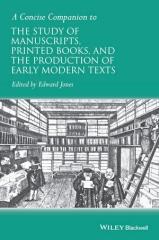Bringing together a broad range of case studies written by a team of international scholars, this Concise Companion establishes how manuscripts and printed books met the needs of two different approaches to literacy in the early modern period.
Features essays illustrating the particular ways a manuscript and a printed book reflect the different emphases of an elite, private and an egalitarian, public culture, both of which account for the literary achievements of the Renaissance
Includes wide-ranging essays, from printing the Gospels in Arabic to a contemporary reconceptualization of Shakespeare's Titus Andronicus
Increases accessibility through a rubric organized around archival and manuscript studies; the provenance of texts and the authority of editions; and studies of genre, religion and literary history
Announces the recovery of archival documents, which in some instances are over four hundred years old
Places translations of Milton's Latin, Greek, and Italian alongside the original texts to increase accessibility for a wide audience of students and scholars
Provides an invaluable platform for highlighting on-going attention to the history of the book and its corollary subjects of reading and writing practices in the 1500s and 1600s

(0 Comentarios)